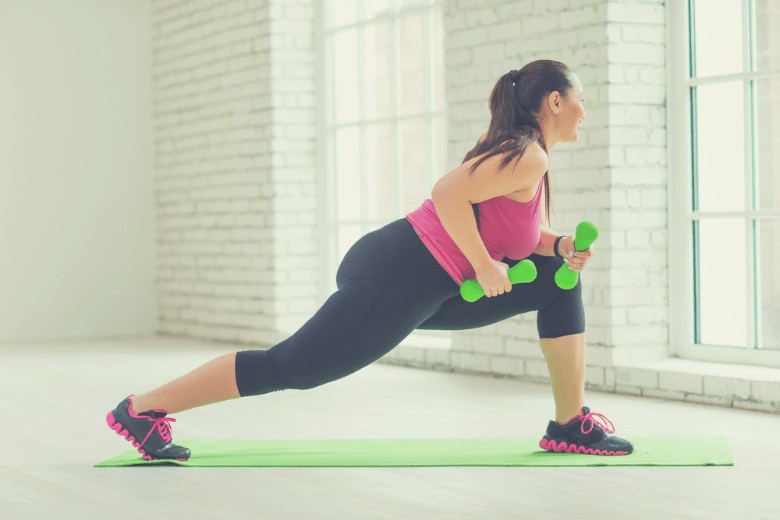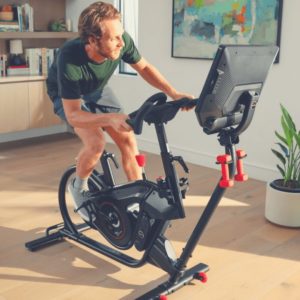It seems like there’s a trendy gym on every corner, and if you’ve walked by one, or several, that make you lose all faith in your ability to lead a fitness-focused healthy lifestyle, you’re not alone.
Whether you’re new to working out, suffer from an injury, or your current weight makes it difficult to consider any type of high-impact workout, you could benefit from low-impact exercise!
I’ve personally dealt with back and foot injuries that made it impossible to include high-impact workouts in my routine.
As I researched the efficacy and benefits of low-impact exercises, I looked for articles that included studies from credible sources that had feedback from medical and fitness professionals, as well as the reputation of the site itself.
Unlike some of the more controversial fitness diatribe, like the best macro percentages for weight loss, or the benefits of the going keto, it was clear that experts could agree on something – you can reap a ton of rewards by including low-impact exercise in your workout schedule.

What is Low-Impact Exercise?
Every time you jump up in the air, gravity pulls your body back down – with force.
This high-impact action puts a lot of stress on your body, but with the benefit of creating massive energy expenditures.
Low-impact exercises don’t include motions that have the jarring effect of high-impact training. If you have at least one foot on the ground, it’s typically a low-impact exercise.
There’s a common misconception that low-impact is interchangeable with low-intensity, which is not the case.
According to the Center for Disease Control, intensity is a measure of the effort required to perform an action.
There are quite a few ways to determine the intensity of your workout.
If you have a smartwatch or fitness tracker, they often do the work for you, so it’s easy to see whether you’re at 50% of your max heart rate or if you’re at 90% of your max.
Ideally, you’d be somewhere between 70% – 90% of your heart rate to see optimal weight loss.
However, a gadget isn’t necessarily needed. You can use a 1-10 scale, something commonly called the rate of perceived exertion, also known as RPE, to gauge intensity.
A one on the RPE scale would be something like doing the dishes or walking around the house.
A ten on the scale would be where you’re breathing heavy and an activity that you could only do for 20-30 seconds at a time.
You can achieve a high-intensity workout by power walking or walking hills, by going to a cardio dance class, even a low-impact cardio kickboxing class.
There are a wide variety of options that can still get your heart pumping.
Low impact workouts can burn just as many calories as their high-impact counterpart, although you may need to work for a more extended period.
On average, you’ll burn between five to nine calories per minute in a low-impact routine, while you may burn nine to ten calories per minute in a high-impact workout.
The trade-off, however, is that while you may burn more per minute, you may not be able to maintain such a high level of intensity for that long.
That said, research continues to come out in support of adding low-intensity, steady-state cardio. Regardless of the intensity, low-impact workouts have a host of benefits to offer.
Benefits of Low Impact Exercises
Let’s dive deeper into these elusive benefits.
1. Joints can Rest Easy
High-impact workouts put a lot of force on your joints, and this is especially true if your technique is less than desirable, which is often the case with people new to fitness.
Even if you don’t currently suffer from joint problems, the repetitive stress on your joints from high-impact training can go beyond normal “wear and tear,” causing joint damage in the long run.

2. Decreases the Chance of Injury
While we’re on the subject of wear and tear, low-impact workouts don’t just decrease the likelihood of joint damage.
Since many low-impact exercises are done at a slower speed, you’re able to focus more on your form, which can prevent tendon injuries, nerve damage, and more.
High impact workouts also require a lot of mobility, which can be a struggle for someone who is recovering from injury or who is a beginner in the world of working out.
3. Increased Mobility and Stability
If eventually smashing a high-impact workout is on your goal list, starting off with low-impact training can help you increase the mobility you’ll need to be able to accomplish your goal safely.
A well-rounded low-impact workout will get your body moving in every direction, and because you’re using slower movements, you’ll get a full range of motion.
This promotes good blood circulation and flow, which can also help with sore muscles. The added perk? Lengthening your muscles can give a boost to the number of calories you burn.
Many low-impact exercises and workouts, like Pilates, have a strong focus on core work along with stationary or single-leg movements.
While this may sound counterintuitive to exercise, these slow, intentional movements help you build your stability.
4. Builds Endurance
The CDC recommends at least 150 minutes of moderate-intensity exercise a week, and low-impact workouts fall into this category.
During a high-impact workout, you put so much pressure on your body that it’s necessary to stick to strict rest days for recovery.
With a low-impact workout, your body is able to recover more quickly, so it’s safe to make it a daily occurrence.
The consistency can help to build your overall endurance. Additionally, because you’re not pushing as hard, you should be able to work out for a longer period of time.
You’ll continue to build your stamina, and before you know it, you’ll be knocking out that 150 minutes in no time.
The key is to ensure that you don’t get complacent. It’s a good idea to switch up your routine every month or so.
You should also increase the intensity of your workouts as your body adapts. You can do this by increasing weights, distance, speed, or time.
5. Builds Muscle
Strength training is one of the most effective low-impact workouts due to its ability to both build muscle and burn a ton of calories.
This includes weight-training exercises like deadlifts and curls, as well as bodyweight exercises like squats and lunge.
It also allows you to easily increase the amount of energy used per movement by increasing the weight. Building muscle, however, isn’t limited to strength training.
By holding poses, using stabilization, and unique movements, other low-impact workouts like yoga and Pilates can be effective in increasing muscle mass.
Increased muscle mass can also increase your metabolic rate, making it easier to shed pounds.
6. Built for Fat Burn
We all want to see that body fat shrink away, and low-impact, low-intensity workouts can do just that.
When you within the correct intensity level, lower than 80% of your maximum heart rate, your body switches it up and burns your fat first.
This is very helpful for those who can’t make it through a long enough high-impact workout to burn through all the carbs and dive into those fat storages.
7. Disease Prevention
Maintaining a healthy diet and consistent exercise routine can help to prevent heart disease, type two diabetes, and reduce blood pressure.
It can also help to reduce the side effects of conditions like postural orthostatic tachycardia syndrome and strengthen your heart, bones, and muscles.
8. Improves Your Moods
As with many types of exercise, you can get a boost to your mood when performing a low-impact workout.
The release of endorphins known as a “runner’s high.” You don’t need to run in order to get this mental health perk.
A study by Harvard showed that an hour walk a day can reduce depression rates by an astounding 26%.
High-impact workouts can also trigger an unwanted hormone response.
When you push your body to its limits, your body releases adrenaline and cortisol; it’s a response meant to help our ancestors fight off lions, tigers, bears, or anything else we could eat or needed to be protected from.
This increase in cortisol levels also results in an inability to lose weight effectively.
Lastly, by lengthening and stretching your muscles, you’ll relieve tension, which can lessen tension headaches and stress.
9. Options Abound
One of the benefits of low-impact workouts is that there is a ton of variety, and most are on the cheaper side of things.
The most common low-impact exercise, and also completely free, is walking. There are no limitations to walking, and you can stick to your regimen regardless of where you are.
Cardio dancing classes are another excellent option, and can typically be found at community centers, streamed online, or even at schools for close to nothing.
Yoga and Pilates classes have become a mainstay in the low-impact workout community. However, it’s essential to find a class that focuses on building your flexibility and mobility gradually when selecting a yoga class.
Some types of Pilates classes work on the floor, while others utilize machines to build on the foundation of the bodyweight movements.
The options are endless and can be as unique as a Tai Chi class to something as innocuous as yard work or going rollerblading.
You can take advantage of machines like rowers, ellipticals, bikes or head to the local pool and get a fantastic workout that feels more like play than work.
10. Increased Motivation
Another significant benefit to low-impact workouts is the ability to maintain motivation.
Because you’re not killing yourself or pushing yourself to the level of pure exhaustion at each workout, the fitness experience changes.
Instead of it being work, it becomes something more like a hobby that you enjoy, which in turn makes it easier to throw on your gym clothes and get to work.
If you’re working out daily, it also keeps you on track and boosts your self-esteem instead of finding that your rest day turns into a rest year.
What’s more, is that because there are so many low-impact exercises to take advantage of, it’s rare to get bored.
11. It’s Meant for Everyone
Sometimes, due to cost, availability, physical limitations, weight, injury, accessibility, or a host of other possibilities, some workouts are out of a person’s reach.
That’s one of the best benefits of low-impact exercise; it works for everyone. Yoga is an excellent example of this.
Thanks to the digital age, we can find thousands of free flows that are on the web for every scenario, whether it’s a Hatha flow for bad knees or a Vinyasa flow to get the heart pumping. It doesn’t require driving or a babysitter; all it takes is you and enough room to lay a mat.
Low-impact workouts can be especially helpful for people with arthritis, those with limited mobility, senior citizens, people suffering from obesity, and pregnant women, but it is also beneficial for people who don’t have a chronic health condition.
Low impact exercises are great options for active rest days in order to optimize fat burn.
Final Thoughts
Before you head off to start your first low-impact workout, there’s one catch. No workout is effective without a fit-focused meal plan.
The saying it’s 80% diet and 20% exercise rings true. It’s also important to remember that your body is the best barometer.
Pay attention to what it’s telling you, and if in doubt, you should always reach out to your doctor.



